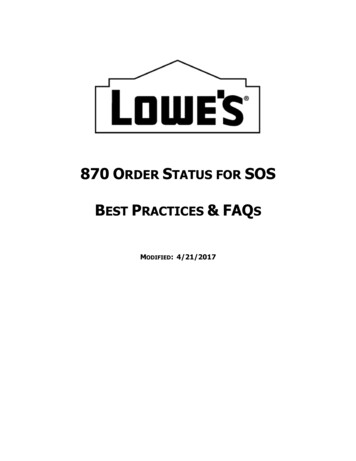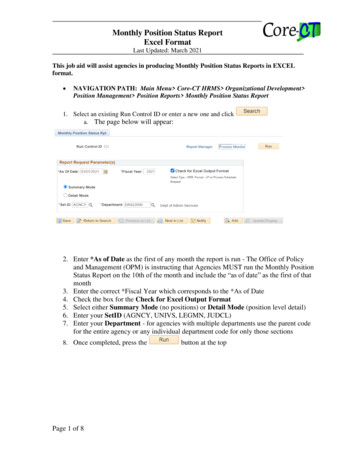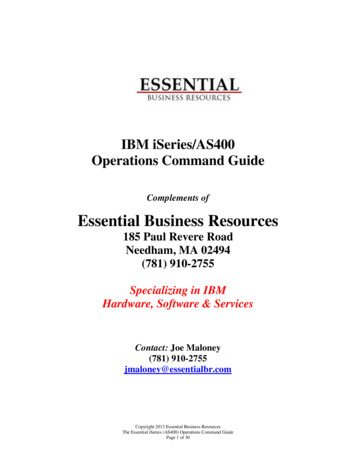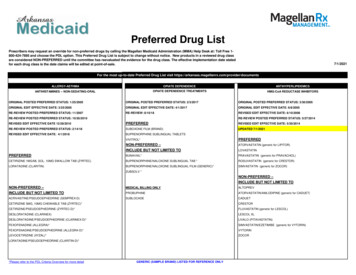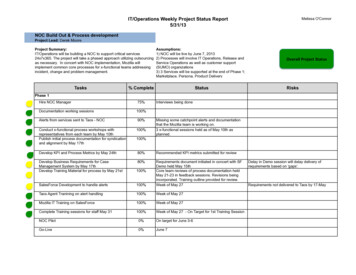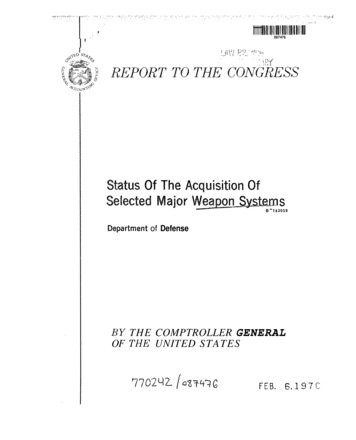
Transcription
I1111111111111111l1Hl1lIIlllllIl1087476I'sB- 163058epartment of DefenseBY THE COMPTROLLER GENERALOF THE UNITED STATESFEB.6,197C
COMPTROLLER GENERAL OF THE UNITED STATESWASHINGTON, D.C. 20548B- 163058To the President of the Senate and theSpeaker of the House of RepresentativesThis is our report on the status of the acquisition ofselected major weapon systems of the Department of Defense. Our review was made pursuant to the Budget and Accounting Act, 1921 (31 U.S.C. 53), and the Accounting andAuditing Act of 1950 (31 U.S.C. 67).Copies of this report a r e being sent to the Director,Bureau of the Budget; the Secretary of Defense; and the Secr e t a r i e s of the Army, Navy, and Air Force.Comptroller Generalof the United States
IIIIIIIIIIIO f the 57 systems, GAO obtained s u f f i c i e n t detail on only 38 t o permita comparison of cost estimates a t different points i n time. GAO fouildIIt h a t , on those 38, the current estimates through program completionwere about 50 percent higher ,than the original planning estimates.GAO points o u t t h a t DOD has recently approved a number o f major weaponsystems for production and t h a t t h e i r i n i t i a l cost estimates couldprove t o be greatly understated, should the same rate of cost growthbe experienced on these newer systems.IGAO believes that one o f the most important causes f o r cost growth i sIIIstarting the acquisition of a weapon system before i t has been adequately demonstrated t h a t there is reasonable expectation o f successfuldevelopment. Because of the substantial number of cases found, GAOconcluded t h a t DOD had n o t been effectively administering this process.IIIIIIGAO believes also thst another significant cause f o r cost growth can beItraced t o the i n i t i a l definition of system mission requirements andtechnical performance specifications, including the estimates o f costst o achieve them. Improvements i n the quality and completeness of suchpreliminary p l a n n i n g will , in GAO's opinion, provide the knowledgewhich could contribtite substantially t o the accurxy of i n i t i a l costestimates.IIIIIIIIIIIIGAO points o u t t h a t cost growth cannot always be anticipated, particul a r l y where a weapon system i s i n development and production over along period o f time. Furthermore, i t i s impor-tant t o recognize i n anyanalysis or discussion of cost growth t h a t not a l l cost growth can bereasonably prevented and t h a t some cost growth , even t h o u g h preventable,may be desirable. (See p. 14.)IIIGAO cowluded t h a t DOD's Selected Acquisition Reporting system, i n con-Icept, represented a meaningful management tool f o r measuring and tracking the progress of major acquisitions. I t was i n i t i a t e d i n February1968 a n d , as w i t h most ner?r management systems, has certain shortcomings. DOD has recognized the need f o r improvement, and GAO has madespecific suggestions t o DOD for i t s consideration i n refining the sys:tern.The status o f the 57 individual programs as of June 30, 1969, is contained i n 10 separate classified volumes designated as parts 7 through10, which are included as appendix V to this report by reference.IIIIIIID u r i n g t h i s review the GAO made many recommendations t o DOD concerningt h e improvement of acquisition management. Subsequently, DOD i n i t i a t e dactions t o correct, or otherwise deal w i t h , the matters discussed i nthis report. Therefore, the GAO report contains no specific recommendations. (See chs. 2 and 4 . )IIIIIIIII2
IIIIIIIIIIIIIIIICOMPTROLLER GENERAL ' REPORT TO THE CONGRESSSTATUS OF THE ACQUISITION OF SELECTEDMAJOR WEAPON SYSTEMSDepartment of Defense B-163058-WHY THE REVIEW VAS MADEI-The General Accounting Office (GAO) examined i n t o the status of selected major weapon systems because o f the large acquisition costs i n volved, and the i n t e r e s t of the Congress i n the acquisition of majordefense weapon sys tems.GAO advised the Chairmen o f the Senate and tiouse Armed Services Committees o f i t s plans t o give increased attention t o the procurement of maj o r weapons systems by l e t t e r s dated August l , 1969.IIIII(See p. 31 .)GAO plans t o continue t o monitor the acquisition of major weapon systems. In addition, GAO i s considering extending this type of review t oother executive agencies.IIIIIIIII&LIFINDIIlrGS AND CONCLUSIONSThe Department o f Defense (DOD) did n o t maintain a central f i l e on thetotal number o f systems being acquired or t h e i r costs. A t GAO's request the DOD attempted t o identify this information. Data furnishedt o GAO as o f June 30, 1969, showed t h a t a total of 131 major programswere i n various phases of the acquisition process'and t h e i r t o t a l costswere estimated t o aggregate about 141 billion. O f this amount, fundsproximating 55 billion had been funded t o the program by the DODthrough June 30, 1969.On the b a s i s of a review o f the status of 57 major weapon systems, asof June 30, 1969, GAO concluded:--That considerable cost growth had been and was continuing t o occuron many current development programs and t h a t numerous reasons wereadvanced by the military services to explain then;. (See ch. 3.)--That significant variances e i t h e r existed o r were anticipated between the performance originally expected and t h a t currently est.i mated f o r a large number o f the systems reviewed. (See ch. 3 . )--That slippage i n the originally established program schedules offrom 6 months t o more t h a n 3 years e i t h e r had been experienced orwere anticipated t o be experienced on many of the system. (Seech. 3 . )Tear SheetI1
IIIIIIIIIIIIIIIAGENCY ACTTONS A ND UNRESOLVEDrssmsOfficials of the Office o f the Secretary of Defense were generally awareof the matters discussed i n this report, and a great deal of attentionhas been and i s continuing t o be given t o their resolution. A ww i n struction on the preparation o f the SARs was issued by the Secretary o fDefense on December 19, 1969. This instruction significantly improvesupon the data required t o be reported and should greatly enhance theusefulness of the Selected Acquisition Report.IIIIIIIIFurther experience i n the report preparati on , together w i t h the cl ari fication provided in the new instructions, should r e s u l t i n the reportsbeing prepared on a more consistent basis.IIIIIIIWith regard t o the cost growth being experienced, the Deputy Secretaryof Defense has acknowledged the need f o r DOD t o focus more attentionon identifying the risks associated w i t h major programs and the thorough completion o f the established prerequisites t o contract definitionA Defense Systems Acquisition Review Council has been recently estab-lished t o ensure t h a t these prerequisites have been met before programsprogress into subsequent phases o f the acquisition cycle.GAO plans t o continue t o monitor the DOD's acquisition o f majoy weaponsys tems .MATTERS FOR CONSIDERATION BY THE CONGR7SSIIIIISeveral committees , subcomi t t e e s , and individual members of the Congress have had a long-standing and keen i n t e r e s t i n the acquisition ofmajor systems by DOD. (See ch. 5.) This report i s being furnished t othe Congress to apprise i t of GAO's findings and conclusions and forsuch action as i t or i t s committees may deem appropriate.IIIIIIIIIIIIIIIIIIIIIIIITear SheetIII3
APPENDIXvI n d i v i d u a l Reports on the S t a t u s of the A c q u i s i t i o n of Selected Major Weapon S y s t e m (bounds ep ar a t e ly )PART1 Department of the Army--AircraftCH-47 HelicopterCHEYENNE HelicopterUH-1H HelicopterAH-1G COBRA Helicopter2Department of the OW3Department of the Army--VehiclesSHERIDAN TankGAMA GOAT4Department of the Navy--AircraftS-3A A i r c r a f tF-14 A i r c r a f tEA-6 A i r c r a f tF-4J A i r c r a f tP-3C A i r c r a f tCH-46 HelicopterA-7E A i r c r a f t5Department of the Navy--AN SystemsAN/SQQ-23 SonarAN/SQS-26 SonarAN/BQQ-2 Sonar
C o n t e n t sm eDIGEST1CHAPTER1INTRODUCTION42THE SELECTED ACQUISITION REPORTING SYSTEMOrigin and purposeScope and proceduresEvaluation of the SAR system77883COST, SCHEDULE, AND PERFORMANCEExperience with system cost estimatesSufficiency of cost variance analysesPotential for cost growthSystem schedule experienceSystem performance1111151617204SUMMARY OBSERVATIONS AND CONCLUSIONS225CONGRESSIONAL CONCERN OVER ACQUISITION OFMAJOR SYSTENS25AVAILABILITY OF INFORMATION REQUESTED BY THEGENERAL ACCOUNTING OFFICE28Letter dated August 1, 1969, from the Comptroller General, U. S. General AccountingOffice to the Chairman, Committee on ArmedServices, United States Senate31I1List of weapon systems selected f o r GAO study34I11Schedule of program cost data appearing onJune 30, 1969, SARs and arranged by acquisition phase and military service36Summary of major acquisitions of the Department of Defense as of June 3 0 , 1969386APPENDIXIIV
ABBREVIATIONSASWDODGAORDT&ESARAntisubmarine WarfareDepartment of DefenseGeneral Accounting Officeresearch, development, test, and evaluationSelected Acquisition Report
PART6Department of the Navy- - MissilesPHOENIX MissilePOSEIDON MissileWALLEYE MissileCONDOR M i s s i l eSTANDARD ARPl MissileSUBROC MissileSPARROW E MissileSPARROW F Missile7Department o f the Navy--OrdnanceMARK 46 TorpedoMARK 48 MOD 0 TorpedoMARK 48 MOD 1 Torpedo8Department of the Navy--ShipsLHA Amphibious A s s a u l t ShipCVA-67 A i r c r a f t CarrierCVAN-68 and CVAN-69 A i r c r a f t CarriersDE-1052 C l a s s , E s c o r t ShipDD-963 F l e e t E s c o r t DestroyerDXGN New Guided Missile F r i g a t eSSN A t t a c k Submarine (Nuclear)9Department of the A i r F o r c e - - A i r c r a f t 3-1Advanced Manned S t r a t e g i c A i r c r a f tF-15 A i r c r a f tC- 5A A i r c r a f tF-111, FB-111, and RF-111 A i r c r a f tA-7D A i r c r a f tAirborne Warning and C o n t r o l System (AWACS)F- 4E A i r c r a f tRF-4C A i r c r a f t10 Department of the A i r Force- - MissilesMAVERICK MissileTITAN I11 MissileS h o r t Range A t t a c k Missile (SRAM)M"II1 and I11 Missile
on only 38 t o permita comparison of cost estimates a t different points i n time. GAO foundt h a t , on those 38, the current estimates through program completionwere about 50 percent higher than the original p l a n n i n g estimates.GAO points out t h a t DOD has recently approved a number o f major weaponsystems for production and t h a t t h e i r i n i t i 1 cost estimates couldprove t o be greatly understated, should the same rate of cost growthbe experienced on these newer systems.Of the 57 systems, GAO obtained s u f f i c i e n t detailGAO believes t h a t one of the most important causes for cost growth isstarting the acquisition of a weapon sy-stem before i t has been adequately demonstrated that there i s reasonab e exDectation o f successfuldevelopment. Because of the substantial number b f cases f o u n d , GAOconcluded t h a t DOD h a d n o t been effectively administering this process.GAO believes also that another significant cause for cost growth can betraced t o the i n i t i a l definition o f system mission requirements andtechnical performance specifications, including the estimates of costst o achieve them. Improvements i n the quality and completeness of suchpreliminary p l a n n i n g will , i n G A O ' s opinion, provide the knowledgewhich could contribute substantially t o the accuracy of i n i t i a l costes tinates .GAO points out t h a t cost growth cannot always be anticipated, particul a r l y where a weapon system i s i n development and production over along period o f time. Furthermore, i t i s important t o recognize i n anyanalysis or discussion of cost growth t h a t n o t a l l cost growth can bereasonably prevented and that some cost growth, even t h o u g h preventable,may be desirable. (See p . 14.)GAO conclilded t h a t DOD's Selected Acquisition Reporting system, i n concept, represented a meaningful management tool for measuring and tracki n g the progress of major acquisitions. I t was i n i t i a t e d i n February1968 a n d , as w i t h most new management systems, has certain shortcomings. DOD has recognized the need f o r improvement, and GAO has madespecific suggestions t o DOD for i t s consideration i n refining the sys-tem.The status of the 57 individual programs as of June 30, 1969, is cont a i n e d i n 10 separate classified volumes designated as parts 1 throughIO, which are included as appendix V t o this report by reference.During t h i s review the GAO made many recommendations t o DOD concerningthe improvement o f acquisition management. Subsequently, DOD i n i t i a t e dactions to correct, or otherwise deal w i t h , the matters discussed i nt h i s report. Therefore , the GAO report contains no specific recommendations. (See chs; 2 and 4.)2
COMPTROLLER GENERAL ' REPORT TO T E CONGRESSSTATUS OF THE ACQUISITION OF SELECTEDMAJOR WEAPON SYSTEMSDepartment of Defense 8-163058-D -IG E- -S- T-WHY THE REVIEW---WAS MADE-The General Accounting Office (GAO) examined into the status of selected major weapon systems because o f the large acquisition costs involved, and the i n t e r e s t of the Congress i n the acquisition o f majordefense weapon sys terns.GAO advised the Chairmen of the Senate and House Armed Services Committees of i t s plans t o give increased attention t o the procurement of major weapons systems by l e t t e r s dated August l , 1969. (See p. 31 .)GAO plans t o continue t o monitor the acquisition of major weapon systems. In addition, GAO i s considering extending this tyoe o f review t oother executive agencies.FINDINGS AND- CONCLUSIONSThe Department o f Defense (DOD) did n o t maintain a central f i l e on thetotal number of systems being acquired or t h e i r costs. lit GAO's request the DOD attempted t o identify t h i s information. Data furnishedt o GAO as of June 30, 1969, showed t h a t a total of 131 major progmmswere in various phases of the acquisition process and t h e i r t o t a l costswere estimated t o aggregate about 141 billion.' Of t h i s amount, fundsproximating 55 billion had been funded t o the programs by the DODthrough June 30, 1969.On the basis of a review of the status of 57 major weapon systems, aso f June 30, 1969, GAO concluded:--That cons,iderable cost growth had Seen and was continuing t o occuron many current development programs and t h a t numerous reasons wereadvanced by the military services t o explain therr,. (See ch. 3 . )--That si g n i f i cant vari ances e i t h e r existed or were anti ci pated between the performance originally expected and t h a t currently e s t i mated for a large number o f the systems reviewed. -(See ch. 3 . )--That slippage i n the originally established prograin schedules o ffrom 6 months t o more than 3 years e i t h e r had been experienced orwere anticipated t o be experienced on many of the systems. (Seech. 3 . )1
CHAPTER 1INTRODUCTIONIn a letter to the Chairman, Senate Committee on ArmedServices, dated August 1, 1969 (see app. I),andin similarletters to other congressional committees, we outlined ourplans for giving greater attention to the procurement ofmajor weapon systems and for periodically reporting ourfindings to the Congress. As our initial effort, we decided to examine into the selected acquisition reportingsystem established by the Department of Defense to monitorand control the acquisition of major weapon systems.During this examination, we examined into the completeness and accuracy of cost, schedule, and performance information contained in the Selected Acquisition Reports (S-4R.s)as of June 30, 1969, involving 57 major weapon systems. Weobtained the most currenr cost, schedule, and performanceinformation available and made certain comparisons of thisinformation with the initial estimates for each of the systems reviewed.In undertaking this review in August 1969, we decidedto examine the S A R s and underlying documentation on a relatively large number of major weapon systems. We, however,confined our examination sufficiently to be able to providethe Congress with this report early in 1970. Therefore ourwork intentionally was limited in scope. Consequently,this report, for the most part, deals with the apparentproblems we identified; it does not include any definiteconclusions as to the precise causes or possible alternative remedies.Additional work is continuing to more fully developunderlying causes of the problems identified and the futureimprovements that may be needed to ensure the timeliness,accuracy, and adequacy of the data reported under the S A Rsystem. Additional detailed reviews of the problems involved in the acquisition of major weapon systems are alsoplanned.4
AGENCY A C T I O N S AND UNRESOLtZD ISSUESOfficials o f the Office of the Secretary of Defense were generally awareo f the matters discussed i n this report, and a great deal o f attentionhas been and i s continuing t o be given t o t h e i r rescfvtion. A new instruction on the preparation of tiie SkRs was issued by the Secretary ofDefense on December 19, 1969. T h i s instruction significantly ir:iprovesupon the data required t o be reported and should greatly enhance theusefulness o f the Selected Acquisition Report.Further experience i n the report preparation, together w i t h t h e clarification provided i n the new instructions, should r e s u l t i n the reportsbeing prepared on a more consis tent basis.W i t h regard t o the cost growth being experienced, the Deputy Secretaryo f Defense has acknowledged the need for DOD t o focus more attentionon identi ying the risks associated w i t h major programs and the thorough comp e t i on of the es t a b 1 i shed prerequi s i tes t o con t r a c t def i n i t i onA Defense Systems Acquisition Review Council has been recently estab-lished t o ensure that these prerequisites have been met before programsn t o subsequent phases of the acquisition cycle.p r ogres sGAO plans t o continue t o monitor the DOD's acquisition of major weaponsys terns.MATTERS FOR COiiSIDZRATION BY TliE CONGRESSl --lSeveral commi ttees , subcommi t t e e s , and i ndi v i dual members of the Congress have had a l o n g- s t a n d i n g and keen i n t e r e s t i n the acquisition ofmajor systems by DOD. (See ch. 5.) T h i s report i s being furnished t othe Congress t o apprise i t o f GAO's findings and conclusions and forsuch action as i t or i t s committees may deem appropriate.3
&Air ForceTotal10521193Total n m b e r or' selectedacquisition reports reviewedStatus in the acquisition cycle:Conceptual phaseDevelopment phaseProduction phaseAnalysis by comodity category:AircraftHi ssi le sAN Systems (electronics)ShipsVehicfes/OPdnanceTotal estimated cost throughcompletion (millions)RDT&EProductionMilitary construction46-378383--86 14,553.5 47,376.7 51,750.8 ,670.839,435.6644 491,948.61,174.420,555,OThe systems reviewed in our exaninations are listed inappendix 11.6
At the outset of our examination, a complete list ofall the major acquisitions was not readily available sincea central file was not maintained in DOD. GAO thereforeattempted, with the cooperation of DOD, to assemble such alist. We established criteria for our use in defining amajor weapon system acquisition to be included in the inventory, which was in general conformance with certain DODcriteria., These were defined as systems expected to requirecumulative research, development, test, and evaluation(RDTSIE) financing in excess of 25 million, or which wereestimated to require cumulative production investment inexcess of 100 million. The initial inventory summarizedby service and displaying the estimated costs through completion and funds programmed through June 30, 1969, isshown as appendix IV.Also using the above monetary criteria, we selectedsystems for our review from systems being procured by eachof the military departments that were in various phases ofthe acquisition cycle (conceptual, developmental, production) and that encompassed a wide range of commodities.Our examination was performed principally at the program/project offices of the military services havingresponsibility for the system acquisition. Some limited work wasperformed also at selected prime contractor locations.The following table indicates, by military department,the resources allocated to the programs reviewed (amountsshown are based on projected service approved programs),their status at the time of our review, and a breakout bycommodity class.5
identify actual or potential problems in acquiring thesemajor defense systems according to plans and authorizations.SCOPE AND PROCEDURESBy DOD Instruction 7000.3, the SAR is directed tothose systems estimated to require a total cumulative financing for research, development, test, and evaluation inexcess of 25 million or cumulative production investmentin excess of 100 million. All the defense systems whichmeet either of these criteria are not necessarily designated for reporting under the SAR system. Designating theprograms to be under the SAR is the responsibility of theAssistant Secretary of Defense (Comptroller), in coordination with the Director of Defense Research and Engineeringand the Assistant Secretaries of Defense (Installations andLogistics) and (System Analysis).These same offices also are required to coordinate andapprove the specific schedule milestone events, performancecharacteristics, and cost data to be included in the SARs.These data are selected and submitted to the Assistant Secretary of Defense by the responsible military departmentupon designation of a system for SAR reporting.SARs are prepared as of the end of each calendar quarter and are to be submitted to the Assistant Secretary ofDefense (Comptroller) within 45 days.EVALUATION OF THE SAR SYSTEMThe SAR system, in concept, represents a meaningfulmanagement tool for measuring and tracking the progress ofmajor acquisitions. At the time of its establishment, theSAR system was intended as an internal DOD information system. Prior to April 1969 the system encompassed only eightacquisition programs and was, for all practical purposeso anexperimental effort. In April 1969 the system was chosenby DOD to play an important role in the monitoring of systernacquisitions and also as the mechanism for developingprogram status information requested by the Senate Pregaredness Investigating Subcommittee. Consequently the number ofprograms designated for the SAR system increased from eightto more than 50 programs as of June 30, 1969.8
CHAPTER 2THE SELECTED ACQUISITION REPORTING SYSTEMO R I G I N AND PURPOSEThe SAR w a s e s t a b l i s h e d by WD.Instruction 7000.3 ofFebruary 23, 1968. P r i o r t o t h e i n t r o d u c t i o n of t h e SAR syst e m , t h e r e were no summary r e c u r r i n g r e p o r t s on major syst e m a c q u i s i t i o n s which r e t a i n e d c o n s i s t e n t c o s t , schedule,and performance d a t a f o r comparison with subsequent e s t i mates.The i n i t i a l purpose of t h e SAR system was t o keep i t ssponsor, t h e A s s i s t a n t Secretary of Defense (Comptroller),apprised as t o t h e progress of s e l e c t e d a c q u i s i t i o n programs and t o compare t h i s progress with t h e planned technic a l , schedule, and c o s t performance. I n 1969, a p p l i c a t i o nof t h e SAR was broadened and strengthened considerably.I n a memorandum t o t h e S e c r e t a r i e s of t h e M i l i t a r y Departments dated August 13, 1969, t h e Deputy Secretary ofDefense defined t h e purpose of t h e S A R more s p e c i f i c a l l y asbeing:"***t h e key r e c u r r i n g summary r e p o r t from p r o j e c tmanagers and t h e M i l i t a r y Departments t o informt h e Secretary of Defense on t h e progress of t h e i rmajor a c q u i s i t i o n programs."The Deputy Secretary a l s o emphasized the need f o r personalinvolvement of a l l managers concerned w i t h t h e major acquis i t i o n process t o ensure t h a t the SARs f a i r l y and accur a t e l y r e f l e c t t h e s t a t u s of the programs being reported.F u r t h e r , t h e D i r e c t o r , Defense Research and Engineeri n g , i n r e c e n t congressional testimony, s t a t e d t h a t t h eSARs form t h e b a s i s f o r Program S t a t u s Reports which areprovided t o t h e Senate Armed Services Committee and o t h e r son s e l e c t e d major system a c q u i s i t i o n s . The Director s t a t e da l s o t h a t t h e r e p o r t s should, i n p a r t , h e l p DOD improve i t smonitoring of t h e progress of development programs and t o7
existing system t o accommodate a new subsystem. In addition, many reports were very voluminous and in such detailthat sheer volwe of paper rendered a ready analysis of thestatus and progress of the system an extremely difficulttask.DOD is aware of many of these problems and shortcomings, and a great deal of attention has been and is continuing to be given to their resolution. Anewinstructton onthe preparation of the SARs was issued by the Secretary ofDefense on December 19 , 1969. This instruction significantly improves upon the data required to be reported andshould greatly enhance the usefulness of the SAR. For example, the instruction specifically deals with many of theshortcomings discussed above. Further experience in reportpreparation, together with the clarification of the new instructions, shoGld result in the reports' being prepared ona more consistent basis,With regard to the costs attributed to inflation, DODadvised us that a Government policy had not yet been determined on the treatment of estimations of c o s t s attributedto inflationary trends in the economy and that efforts wereunder way to study the issue.-lo
A s with any new reporting system, the SAR system hadserious shortcomings and there are several areas where improvements are essential.At the time of our examination, the SAR was not sufficiently encompassing, and therefore failed to disclose,significant matters concerning the progress of major acquisitions. For instance:1. Although appraisals of certain specified technicalfeatures of the systems are required (weight,range, speed, accuracy, etc.), the results of acomparison of the technical performance actuallydemonstrated with that specified in the contractwere not required to be reported.2. In certain reports the status of certain key subsystems was not required to be reported. Most frequently these concern schedule and technical information on Government-furnished equipment. Additionally, it was noted that in certain instances enditems were delivered without critical componentsand no mention was made in the reports.3 . Cost incurred in relationship to the cost thatshould have been incurred for the physical progressof the work attained at a particular point in timewas not reported.4. Significant pending decisions that may have a majorimpact on the program, such as changes in quantities or deliveries, were not reported.5. A comparison of quantities delivered with thosescheduled to be delivered at the same point in timew a s not made.We also noted inconsistencies in the data reported inthe SARs. For example, there was a lack of consistency in(1) the reporting of early developmental c o s t s , (2) treatment of costs attributed to inflationary trends in the economy, ( 3 ) treatment of costs involving contract incentive/penalty provisions and claims for equitable adjustments,and ( 4 ) the reporting of costs involved in modifying an9
Item 3 above is shown as planned costs at currentquantities on the SAR. We have changed this column headingto show that costs have been adjusted f o r quantity changes.If there is not a change in quantity, this column would bethe same as either the planning estimate or the contractdefinition estimate column depending on the acquisitionphase of the system.The current estimate through program completion is intended to be a current, objective estimate of the costs expected to be incurred to accomplish the entire program andis adjusted for such items as changes in quantity as wellas current estimates of cost due to inflation, changes inscope, capability increases, and program stretch-outs.Of the SARs we reviewed, only 38 of the systems thathad advanced to engineering o r operational systems development provided sufficient cost detail to permit a meaningfulevaluation of estimated cost performance. The r e s u l t s ofthis evaluation are shown in the following tabulation.SAR Cost Estimates as of June 30, 1969Earliere st imatesContractPlanning definitionestimate estimateNumberof systemsadjusted te a) completion(miIlions)Army (8)Navy (22) 5,914.218,042.418,009,9Air Force (8)Total (38) 41,966.5- 7,679.9 8 654.522,309.623,220.918,166.828,758.925,475.9 49,841e3 49,067.6 62,889.3 6,087.721,444.0?he SBR heading for this column is Planned C o s t s at Current Quantitye12
CHAPTER 3COST, SCHEDULE, AND PERFQRMANCENumerous reasons f o r changes to original program planswere contained in the SARs. Additional insight as to ressons for changes was gained by us as a result of evaluationof individual reports and discussions with the persons responsible for the programs. The data we collected duringour review were analyzed by the three basic performance indicators--cost, schedule, and technical performance.Each of these indicators is discussed separately int h i s chapter. Our findings regarding the adequacy of thevariance analysis shown in the SAR are also included inthis chapter.EXPERIENCE WITH SYSTEM COST ESTIMATESDOD instructions require that estimated program costdata be displayed in columnar fo-rn on the SAR to show:1. Planning estimate.2. Contract definition cost estimate,3 . Earlier estimates adju
SSN Attack Submarine (Nuclear) 9 Department of the Air Force--Aircraft 3-1 Advanced Manned Strategic Aircraft F-15 Aircraft C-5A Aircraft F-111, FB-111, and RF-111 Aircraft A-7D Aircraft Airborne Warning and Control System (AWACS) F- 4E Aircraft RF-4C Aircraft 10 Department of the Air Force -Mis

